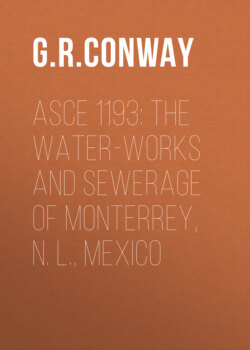Читать книгу ASCE 1193: The Water-Works and Sewerage of Monterrey, N. L., Mexico - G. R. G. Conway - Страница 6
На сайте Литреса книга снята с продажи.
Population, Area, and Mortality.
ОглавлениеTable of Contents
The population of Monterrey has increased as follows:
| Census | of | 1851 | 14,621 | |
| " | " | 1861 | 26,000 | |
| " | " | 1871 | 33,811 | |
| " | " | 1881 | 39,456 | |
| " | " | 1891 | 41,154 | |
| " | " | 1901 | 73,508 | |
| (Estimated) | 1909 | 86,000 to 90,000 |
The greatest progress, it will be noted, was between 1891-1901, with an increase of more than 22,000 in 10 years. In designing the new works, provision has been made for the future requirements of a city of 200,000 persons.
The actual area within the city limits proper is 960.5 hectares (2,374 acres), forming the area to be provided with water and drainage, but the municipal district extends to many surrounding suburbs, and covers an area of 33,758 hectares (83,426 acres).
TABLE 1.—Population And Death Rate Of Monterrey, N. L.,
Mexico, From 1901 To 1909, Inclusive.
| Year. | Population. (Census Est.) | Deaths from all causes. | Rate per 1,000. | Deaths From Typhoid Fever. | Deaths from Typhoid fever per year per 100,000 population. | ||||||||||||
| Jan. | Feb. | Mar. | Apr. | May. | Jne. | Jly. | Aug. | Sep. | Oct. | Nov. | Dec. | Total for year. | |||||
| 1901 | 73,508 | 2,965 | 40.3 | 0 | 2 | 1 | 3 | 4 | 3 | 6 | 6 | 3 | 6 | 4 | 2 | 40 | 54 |
| 1902 | 74,500 | 3,338 | 44.8 | 1 | 4 | 2 | 3 | 6 | 5 | 3 | 1 | 1 | 2 | 3 | 5 | 36 | 48 |
| 1903 | 76,000 | 3,825 | 50.3 | 3 | 2 | 4 | 1 | 0 | 5 | 3 | 5 | 6 | 16 | 3 | 1 | 49 | 64 |
| 1904 | 77,500 | 2,905 | 37.4 | 0 | 1 | 1 | 5 | 3 | 3 | 3 | 4 | 1 | 5 | 1 | 0 | 27 | 35 |
| 1905 | 79,000 | 2,951 | 37.4 | 2 | 0 | 0 | 3 | 3 | 7 | 6 | 3 | 2 | 7 | 2 | 2 | 37 | 47 |
| 1906 | 80,000 | 2,935 | 36.7 | 1 | 2 | 1 | 3 | 3 | 6 | 5 | 3 | 2 | 1 | 2 | 3 | 32 | 40 |
| 1907 | 82,500 | 3,269 | 39.6 | 4 | 6 | 3 | 3 | 5 | 6 | 4 | 4 | 9 | 3 | 0 | 3 | 50 | 61 |
| 1908 | 84,000 | 3,188 | 37.9 | 5 | 2 | 5 | 3 | 8 | 5 | 9 | 7 | 2 | 7 | 4 | 0 | 57 | 68 |
| 1909 | 86,000 | [4]3,477 | 40.4 | 5 | 1 | 4 | 5 | 13 | 11 | 15 | 12 | 6 | 8 | 3 | 4 | 87 | 101 |
[4] Excluding deaths due to drowning in the great flood of August 27th and 28th.
Table 1 gives particulars of the death rate for 1901 to 1909, inclusive, and data relative to the mortality due to typhoid fever. The high death rate is caused by the excessive infantile mortality, which is so prevalent throughout the whole of Mexico. The climatic condition of Monterrey, with its exceptionally healthy subsoil, ought to make it one of the healthiest of cities, if proper care were taken to enforce sanitary laws. The data regarding typhoid mortality are probably understated, as they were compiled by the writer, in the absence of any official publications, from the actual death certificates, but no special care is taken by the authorities to insure accuracy in such certificates. Attention is called to the typhoid rate in May, June, July, and August, 1909; this high rate coincides with a scarcity of rainfall and the greatest period of drought experienced in 30 years, and immediately precedes the great flood of August 27th. It was probably due to the lowering of the ground-water throughout the city and the consequent contamination of the private wells, which were largely in use during that time. Throughout the city the wells are sunk to a depth of about 12 or 15 m., in order to reach the subterranean waters, and the cesspools are often in dangerous proximity to them and at a much higher level. The nature of the subsoil, which is often much fissured and open in the conglomerate and sillar strata, would make the passage of contamination an easy matter, and this alone would account for a high mortality due to water-borne diseases.
